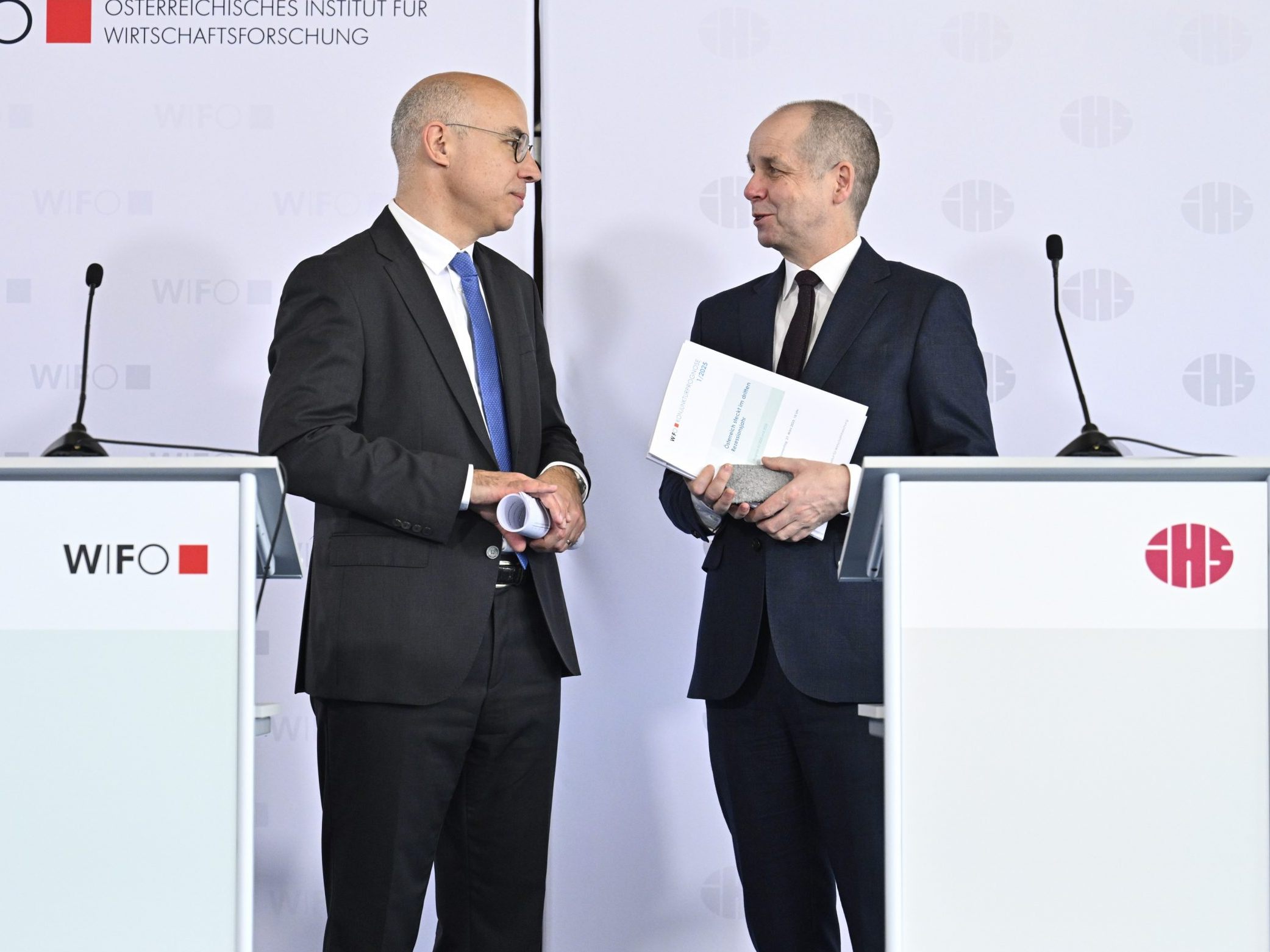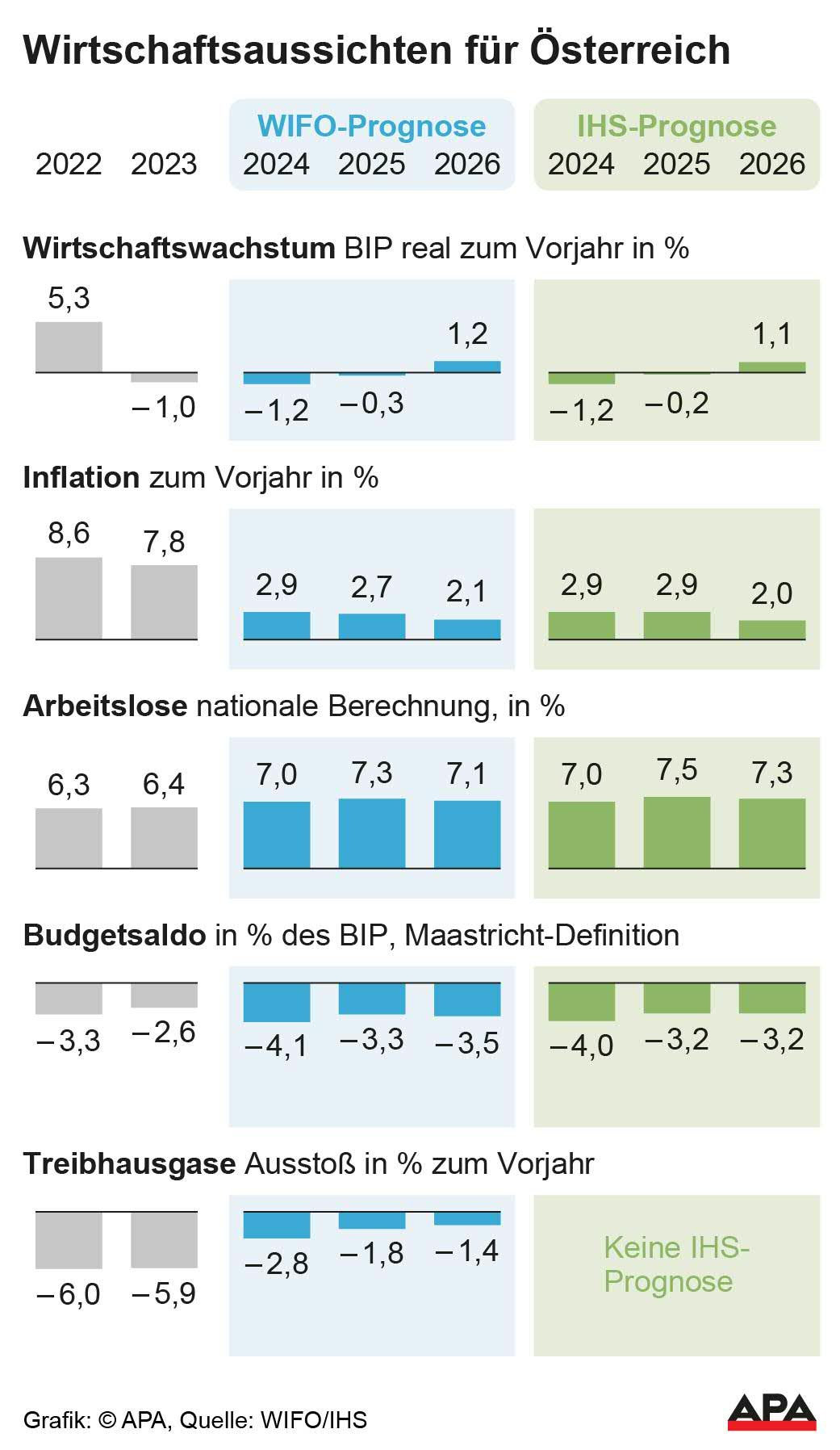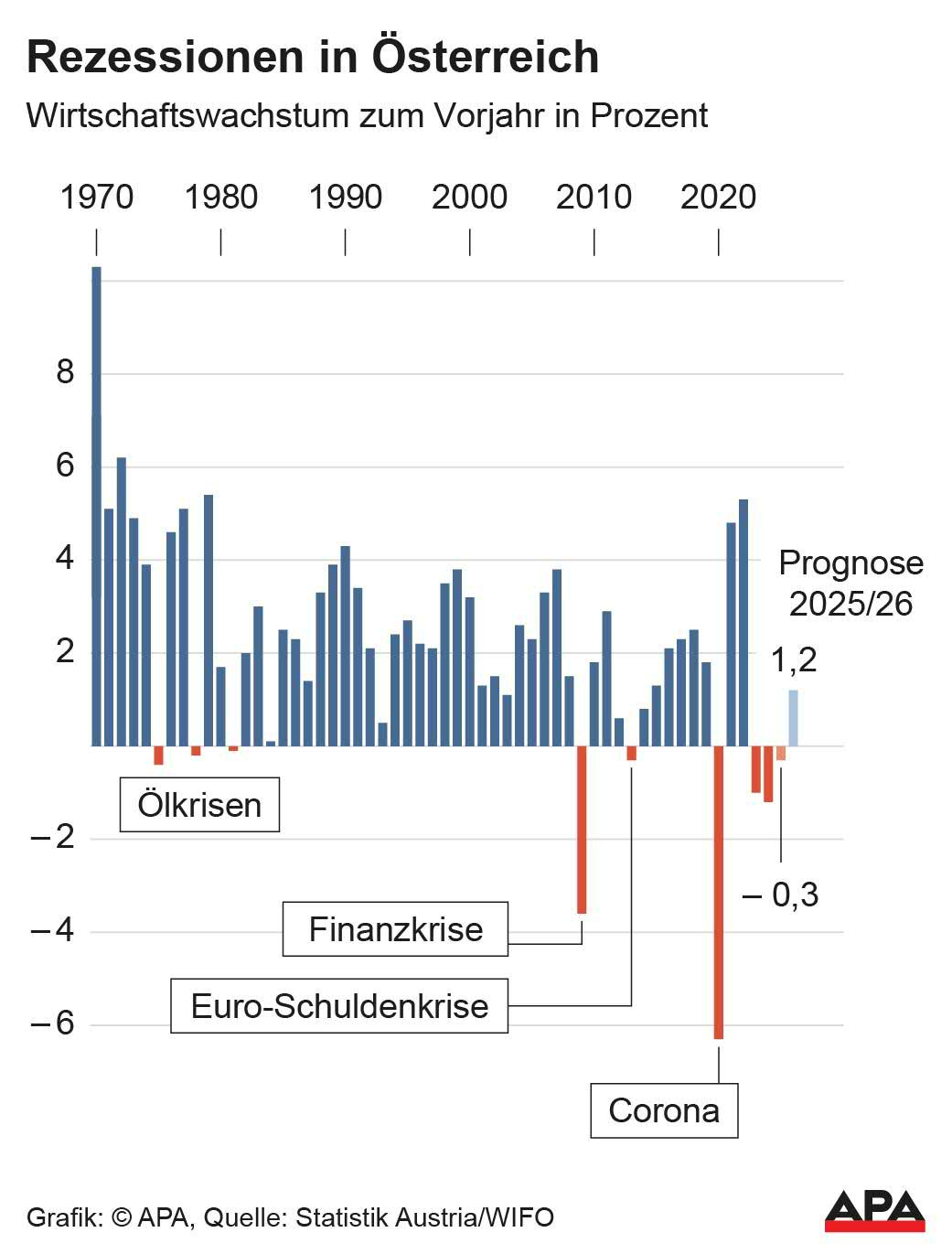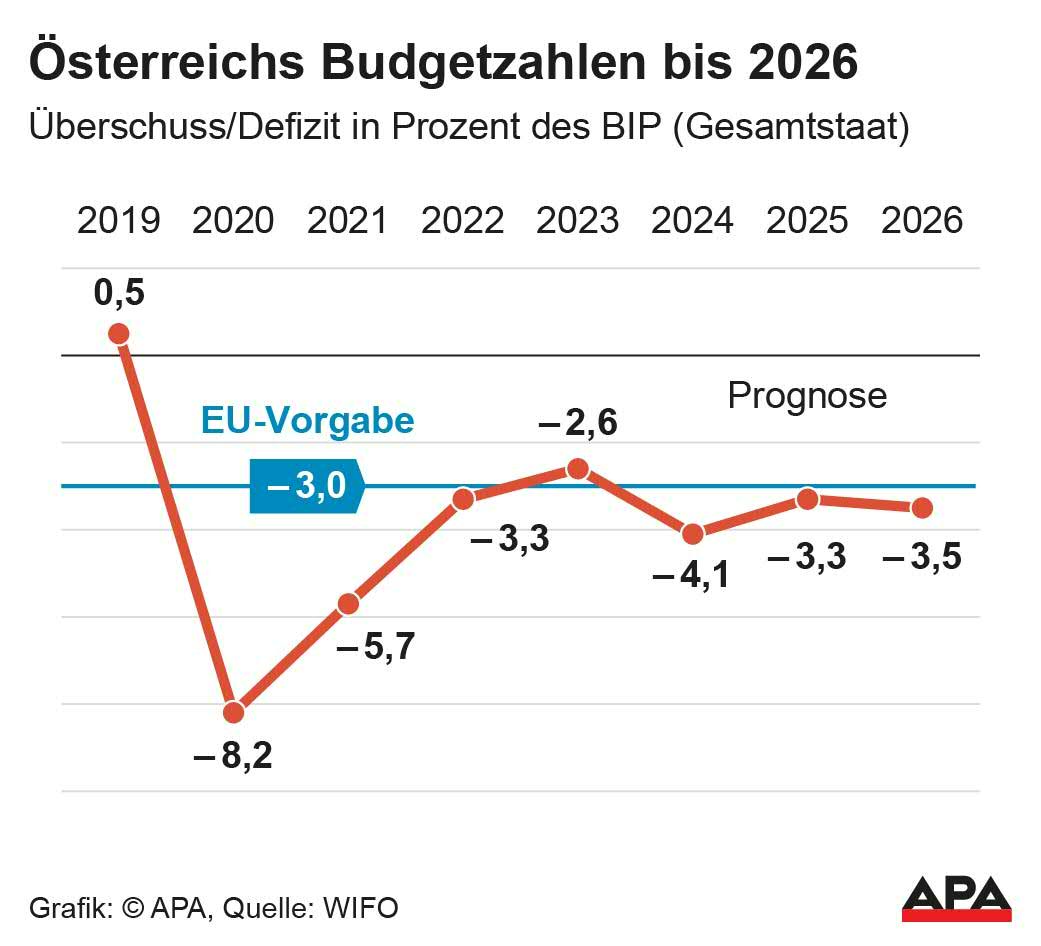Wifo and IHS Expect a Deficit of More Than 3 Percent

According to the forecast, the budget deficit last year was 4.1 percent (Wifo) and 4.0 percent (IHS) of the gross domestic product (GDP). Statistics Austria will publish the state's revenues and expenditures at the federal, state, municipal level, as well as in the area of social insurance carriers for 2024 next week, thereby officially announcing the overall state budget balance.
Wifo and IHS warn of a lost decade
If the US tariff conflict with the USA escalates further and heavily burdens the global economy, a fourth recession year in Austria cannot be ruled out for the economists. In December, the economic researchers still expected economic growth in this country of 0.6 and 0.7 percent for this year, but now a decline of 0.3 and 0.2 percent is forecasted. The domestic economy developed by far the weakest in the EU comparison in 2024. In 2023, the real gross domestic product (GDP) in Austria shrank by 1.0 percent and in 2024 by 1.2 percent.

"Austria is in an economic crisis," said Wifo Director Gabriel Felbermayr at the presentation of the economic forecast in Vienna. The crisis is "partly structural" and "self-inflicted," the new federal government must tackle "bold structural reforms," such as in the area of pensions or federalism. The Wifo chief warned of a decade without economic growth, a "lost decade" in Austria, if the government does not act decisively. IHS chief Holger Bonin fully supports Felbermayr's "wake-up call." It requires "a package of ambitious reforms" and "a national effort." Austria has "largely in its own hands to solve the problems," Bonin explained.

Wifo: Several problem areas of the domestic economy
The Wifo chief pointed to several problem areas of the domestic economy. The real gross domestic product (GDP) per capita is expected to be 2.5 percent lower in 2025 than in 2019, but the available private income per capita 2 percent higher. "The crisis has not yet reached the average household," said Felbermayr. The stabilization of incomes was achieved through state transfers and high wage settlements. The industrial recession in Austria is particularly deep. The domestic industry is expected to continue shrinking in 2025 and fall back to the level of 2018, the Wifo chief expects. The industry has significantly lost competitiveness in recent years.

Both economists view the linkage of salaries and wages, rents, and social benefits in Austria to inflation critically. This is "an Austrian peculiarity" and brings "location disadvantages," said Bonin. The two economic researchers recommend that the public sector remain "cautiously" below the inflation rate for pension and salary increases in the coming years to advance budget consolidation. The union should also show some wage restraint in collective bargaining negotiations so that the economic engine can restart, the top economists explained.
Wifo and IHS see hard austerity pressure in the coming years
The budget deficit is expected to exceed the Maastricht limit of 3 percent of GDP again in 2025 and, despite the austerity package, to be at 3.3 percent (Wifo) and 3.2 percent (IHS). "The budget consolidation by the new federal government dampens growth by 0.3 percentage points," calculates the Institute for Advanced Studies (IHS) in the economic forecast. To avoid stifling the economy further, the new ÖVP/SPÖ/NEOS government should implement the savings of 6.3 billion euros announced for this year, but not save even more, according to Wifo and IHS. An EU deficit procedure is "not a big deal," emphasized Felbermayr. For Bonin, "a pragmatic policy in crisis mode" is needed.
Inflation Barely Decreases According to Wifo and IHS
After the record inflation years of 2022 and 2023 with 8.6 percent and 7.8 percent, inflation decreased to 2.9 percent in 2024 and is expected to be 2.7 percent (Wifo) or 2.9 percent (IHS) this year. The expiration of the electricity price brake, the increase in network charges for electricity and natural gas, and the increase in renewable energy subsidies and CO2 tax have significantly increased inflation in Austria at the beginning of 2025. However, economic researchers expect a declining inflation rate over the course of the year. Inflation in Austria is still "too high" compared to the Eurozone, according to the Wifo chief. This year, inflation is expected to be 0.5 percentage points higher than the Eurozone average, while last year the inflation rate was 0.6 percentage points higher than the Eurozone average.
Labor Market "Relatively Robust"
According to Wifo economists, the labor market is proving to be "relatively robust given the duration and severity of the recession." The IHS sees it similarly: "In historical comparison, the labor market situation is still quite stable." This year, an increase in the unemployment rate by 0.3 or 0.5 percentage points to 7.3 or 7.5 percent is expected according to national calculations. IHS economists point to "severe downside risks" for the economic forecast. Political uncertainty has "increased significantly" since Donald Trump was elected US President. "Erratic changes" in international economic policy - including US tariff policy - make the forecast more difficult, according to Wifo. The German billion-euro financial package and the planned EU armament also increase forecast uncertainty.
Wifo and IHS: Slight Economic Upturn Could Come in 2026
If the Austrian and global economy develops as currently forecast this year, the long-awaited upturn will come in 2026 according to Wifo and IHS. Economic growth is expected to be 1.2 percent and 1.1 percent next year. Inflation is forecast to decrease significantly to 2.1 and 2.0 percent in 2026, and the unemployment rate is expected to slightly decrease to 7.1 and 7.3.
FPÖ economic spokesperson Barbara Kolm warned again about the impacts of an EU deficit procedure. This is "not a fate with unforeseeable additional burdens and reputational damage, but a very conscious political decision by this government," Kolm said in a statement. The budget spokesperson for the Greens, Jakob Schwarz, recommended that the federal government save billions in climate-damaging subsidies and not allow the controversial Lobau tunnel in Vienna. The Chamber of Labor is urging labor market policy measures in the area of training and further education for job seekers and employees in view of rising unemployment figures. The IV called for an increase in the investment allowance as a short-term measure "to reduce the tax burden on investment reserves."
Due to the economic downturn ongoing since 2023, the unions are pushing for economic stimulus packages. ÖGB chief economist Angela Pfister advocates for "an offensive package for social housing, infrastructure, as well as for cities and municipalities." The head of the vida union, Roman Hebenstreit, wants the government to pursue "an active labor market and economic policy" focusing on training, job security, and improvements in the service sector. The federal chairman of the production union (PRO-GE), Reinhold Binder, has little understanding for wage restraint: "If zero wage rounds or collective agreements below the inflation rate are demanded, it will lead to further consumer restraint."
(APA/Red)
This article has been automatically translated, read the original article here.





